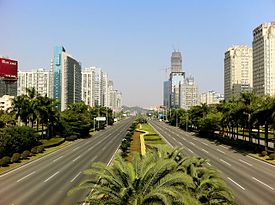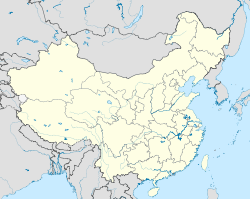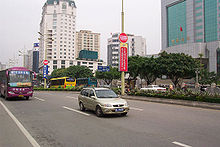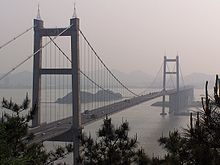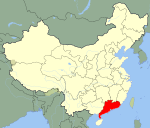- Dongguan
-
For other uses, see Dongguan (disambiguation).
Dongguan
东莞— Prefecture-level city — City of Dongguan · 东莞市 Dongguan Avenue, Central Business District Location in Guangdong Location in China Coordinates: 23°2′N 113°43′E / 23.033°N 113.717°ECoordinates: 23°2′N 113°43′E / 23.033°N 113.717°E Country People's Republic of China Province Guangdong Founded 331 A.D.[1] Government – CPC Committee Secretary Liu Zhigeng (刘志庚) – Mayor Li Yuquan (李毓全) Area – Total 2,465 km2 (951.7 sq mi) Population (2010) – Total 8,220,237 – Density 3,334.8/km2 (8,637/sq mi) Time zone China Standard Time (UTC+8) Postal code 523000 Area code(s) 769 License plate prefixes 粤S GDP - Total ¥ 424.6 billion (2010) - Per capita ¥ 53,285 (2008) City flower Yulan magnolia
Magnolia denudataWebsite http://www.dongguan.gov.cn/ Dongguan (simplified Chinese: 东莞; traditional Chinese: 東莞; pinyin: Dōngguǎn, Mandarin pronunciation: [tʊ́ŋkwàn]; Cantonese: Dung1 gun2; old spelling Tung-kuan) is a prefecture-level city in central Guangdong province, People's Republic of China.
An important industrial city located in the Pearl River Delta, Dongguan borders the provincial capital of Guangzhou to the north, Huizhou to the northeast, Shenzhen to the south, and the Pearl River to the west.
It is also home to the world's largest, though mostly empty, shopping mall, New South China Mall. City administration is considered especially progressive in seeking foreign direct investment. The three neighboring municipalities of Guangzhou, Dongguan, and Shenzhen are home to over 25 million residents, accounting for a large proportion of the Pearl River Delta Region's population.[2]
Dongguan ranks behind only Shenzhen, Shanghai and Suzhou in exports among Chinese cities, with $65.54bn in shipment.
Contents
Administration
Dongguan has no intermediate county level; instead it is divided into:
4 township level divisions, all of which are Subdistricts.
- Guancheng District (莞城区)
- Dongcheng District (东城区)
- Wanjiang District (万江区)
- Nancheng District (南城区)
Following 28 towns.
- Mayong Town (麻涌镇)
- Shilong Town (石龙镇)
- Humen Town (虎门镇)
- Daojiao Town (道滘镇)
- Shijie Town (石碣镇)
- Hongmei Town (洪梅镇)
- Liaobu Town (寮步镇)
- Dalingshan Town (大岭山镇)
- Dalang Town (大朗镇)
- Huangjiang Town (黄江镇)
- Zhangmutou Town (樟木头镇)
- Fenggang Town (凤岗镇)
- Tangxia Town (塘厦镇)
- Qingxi Town (清溪镇)
- Changping Town (常平镇)
- Qiaotou Town (桥头镇)
- Hengli Town (横沥镇)
- Dongkeng Town (东坑镇)
- Qishi Town (企石镇)
- Shipai Town (石排镇)
- Chashan Town (茶山镇)
- Chang'an Town (长安镇)
- Gaobu Town (高埗镇)
- Shatian Town (沙田镇)
- Wangniudun Town (望牛墩镇)
- Xiegang Town (谢岗镇)
- Zhongtang Town (中堂镇)
- Houjie Town (厚街镇)
Geography
 Guan Yin Shan (Kuan Yin Mountain) in Dongguan, China
Guan Yin Shan (Kuan Yin Mountain) in Dongguan, China
The urban center of Dongguan is 50 km away from that of Guangzhou to its north, 90 km away from Shenzhen to its south, 47 nautical miles (87 km) away from Hong Kong and 48 nautical miles (89 km) from Macau by waterway. Dongguan is a must-pass-by locality from Guangzhou to Hong Kong by road or waterway.
Of the total area of Dongguan, 27% is water, 25% forest land, and 13% plow land, while 35% of its land area has been fully developed.
Climate
The climate of Dongguan is humid subtropical. It lies south of the Tropic of Cancer. The average temperature is 22.8 °C (73.0 °F) throughout the year. The average rainfall is 1,756.8 millimetres (69.17 in).[3]
Demographics
Dongguan had 6,949,800 inhabitants at the end of 2008, among which there are 1,748,700 local residents and 5,201,100 permanent migrants from other parts of the country.
Dongguan is also a known hometown for many overseas Chinese, the root for over 700,000 people in Hong Kong, Taiwan and Macau and over 200,000 nationals living abroad.
Transport
Many foreign travelers to Dongguan fly into Hong Kong, which gives visa on arrival to citizens of over 170 countries. After landing, visitors must apply for a visa to enter mainland China.
One can travel from Hong Kong to Dongguan by bus, ferry, or train. Passengers travelling overland must disembark from their transport at the Hong Kong/China border to go through customs and immigration, except for those traveling on the Mass Transit Railway intercity services (former Kowloon-Canton Railway) from Hung Hom Station to Dongguan, Guangzhou and beyond.
Depending on the time of day, using the ferry may be the most convenient way to travel from Hong Kong, as it allows one to avoid long queues at the land border checkpoint between Hong Kong and mainland China.
Dongguan serves as one of the regional railway hub in Guangdong, where Guangzhou-Kowloon Railway, Guangzhou-Meizhou-Shantou Railway and Beijing-Kowloon converge.
Rail services in and out of the city call at Dongguan railway station where there are direct train services to Guangzhou East railway station in Guangzhou; and Hung Hom Railway station in Hong Kong.
The Humen Pearl River Bridge is a suspension bridge over the Pearl River. Completed in 1997, it has a main span of 888 m.
Economy
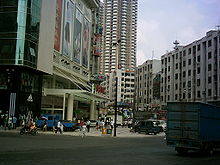 Town centre of Zhangmutou, Dongguan
Town centre of Zhangmutou, Dongguan
City administration is considered especially progressive in seeking foreign direct investment. In 2005, the city hosted the first-ever Sino-American Forum of Intellectual Property Rights, co-organized by the Patent Protection Association of China - PPAC and the International Association for Technology Trade (IATT) as well as what has been identified as the world's largest educational technology conference and expo, co-organized by IATT and the International Society for Technology in Education (ISTE), attracting nearly 40,000 attendees in its first year.
The Dongguan Science & Technology Museum (opened in December 2005), the high tech commerce park in the SongShan Lake district (which debuted in 2003) and a partnership with the Global IT Academy of the Brea Olinda Unified School District in Southern California have demonstrated the city's emphasis on attracting technology business. The city also announced in 2005 a planned investment of US$500-Million over five years for technology infrastructure improvements.
The city and province have been the recent focus of press and journalist attention with coverage of the arrival of teenaged Chinese workers, principally females (so-called factory girls), from agricultural areas to work in the area's factories and manufacturing/assembly facilities, where many are housed in large domitories, usually several to a room.[4]
An article in the High Tech Misery in China series reports research conducted, over 2008 - 2009, on working conditions at one of the city's major keyboard makers (Dongguan Meitai Plastics & Electronics Factory); in it, Meitai factory won some unwanted attention, due to the disappointing conditions for its young, mostly female workers. The PDF article[5] includes details of those conditions, photos, translations of employer's rules and evidence that well-known computer brands use this keyboard supplier's products.
While the city is the third largest exporting region in China, behind Shanghai and Shenzhen (and a major center for Taiwanese investment), outside of China, Dongguan has yet to gain the kind of name recognition realized by Shenzhen (just an hour away, and down-river from Dongguan). This may be because the city has placed an emphasis on investing in infrastructure, rather than directly targeting major corporations with financial incentives for economic development. Still, Dongguan has been identified by high level representatives of the National Development and Reform Commission of the central government as being one of the most significant growth regions for technology in the coming years. As part of this plan the Dongguan local government has announced a plan to create and support a 100 Billion RMB photovoltaic manufacturing industry by 2015.[6]
To cope with the strike of financial crisis, Dongguan city has developed the solutions to step out of the difficulties in order to push forward the city’s industrial restructuring, transformation and upgrade. The city starts a series of study and discussion activities on applying scientific concept on development of the four-pillar platforms - governmental service, supporting measures, technology upgrade and market expansion - to give strong support for transformation of processing trade enterprises in Guangdong province. Through a series of effective measures, Dongguan industrial restructuring has achieved preliminary results. Its industrial restructuring has already enhanced the city’s capability of independent innovation and the quantity of patent applications in 2008. Such intention were further confirmed by the visit of Chinese Premier Wen Jiabao in Dongguan back in July 2008 at some high technology enterprises where Wen gave strong encouragement and compliments on their innovative technologies, such as Dongguan Anwell Digital Machinery Co., Ltd. (a subsidiary of a Singapore listed company), Dongguan Konka Electronic Co., Ltd., and Hua Bao Shoes Co.,Ltd.[7][8]
International relations
Main article: List of twin towns and sister cities in ChinaTwin towns — Sister cities
Dongguan is twinned with:
 Hartford, Connecticut, United States since (March 5, 2001) [9]
Hartford, Connecticut, United States since (March 5, 2001) [9] Thessaloniki, Greece since (October 24, 2008) [10]
Thessaloniki, Greece since (October 24, 2008) [10]
See also
- Dongguan New Century
- Guangdong Southern Tigers
- Lanwa FC plays in the Hong Kong, not Chinese, football pyramid
- New South China Mall: World's second largest mall.
References
- ^ "Dongguan information, History of Dongguan, culture, climate, hotels, map, travel, tourism, tourist, weather, travel tips.". HotelTravel.com. http://www.hoteltravel.com/china/dongguan/guides/overview.htm. Retrieved 2010-05-06.
- ^ "Livable Dongguan". Liveable.dg.gov.cn. http://liveable.dg.gov.cn/about/default.htm. Retrieved 2010-05-06.
- ^ "Livable Dongguan". Liveable.dg.gov.cn. http://liveable.dg.gov.cn/about/natural.htm. Retrieved 2010-05-06.
- ^ Chang, Leslie T., Factory Girls: From Village to City In A Changing China, New York: Random House (2008), ISBN 9780385520171
- ^ The Dehumanization of Young Workers Producing Our Computer Keyboards, New York: The National Labor Committee
http://www.nlcnet.org/admin/media/document/China/2009_meitai/HIGHTECH_MISERY_CHINA_WEB.pdf
http://wen.org.cn/xu/HIGHTECH_MISERY_CHINA_WEB.pdf (Feb 2009, pp 63) - ^ "China Market Pulse". The China Perspective. 2011-01-12. http://www.thechinaperspective.com/articles/chinamarketpulseaviationpremiumincometourismlabormarket8088/index.html.
- ^ "Change with innovation for Dongguan city". Dongguan daily digital newspaper. 2008-07-22. http://epaper.timedg.com/html/2008-07/22/content_180021.htm.
- ^ "Chinese premier pays a visit". NextInsight. 2008-07-22. http://nextinsight.net/index.php/story-archive-mainmenu-60/32-2008/482-anwell-chinese-premier-pays-a-visit.
- ^ "Donguan Forges Sister-city Relations With Hartford". People's Daily. http://english.people.com.cn/english/200102/23/eng20010223_63186.html. Retrieved 2008-10-27.
- ^ "Dongguan and Thessaloniki Formed Sisterhood (in Chinese)". City of Dongguan. http://www.sun0769.com/subject/2008/DgThessaloniki/. Retrieved 2008-10-27.
- Economic data
External links
- Dongguan City Government (Chinese) and (English)
- www.dongguantoday.com Government funded website, giving a full range of information about Dongguan (Chinese) and (English)
- Dongguan Bureau of Foreign Trade & Economic Cooperation (Chinese) and (English)
- IATT - International Association for Technology Trade
- Expats in Dongguan - Expatacular - Expat Community
Guangdong topics General Geography Cities • Pearl River mega-city • Leizhou Peninsula • Pearl River Delta • Northern Guangdong • East River • West River • Nanling Mountains • Pratas IslandsEducation Guangzhou Education • Shenzhen Education • Shenzhen University • Huizhou University • Guangdong Institute of Education • Guangzhou UniversityCulture Lingnan culture • Music • Guangdong music (genre) • Cantonese opera • Teochew people • Hakka people • Hailufeng dialectCuisine Cantonese cuisine • White boiled shrimp • Cantonese fried rice • Chinese steamed eggs • Beef chow fun • Chow mein • Char siu • Roasted suckling pig • Bird's nest soup • Seafood birdsnestVisitor attractions Danxia Mountain • Seven Star Crags • Dinghu Mountain • Xinfengjiang Reservoir • Zhongshan Park • Guangdong Provincial MuseumGuangdong Province county-level divisions Guangzhou: Baiyun District · Haizhu District · Huadu District · Huangpu District · Liwan District · Luogang District · Nansha District · Panyu District · Tianhe District · Yuexiu District · Conghua City · Zengcheng
Shenzhen: Bao'an District · Futian District · Longgang District · Luohu District · Nanshan District · Yantian District · Guangming New Area* · Pingshan New Area*
Zhuhai: Doumen District · Jinwan District · Xiangzhou District · Hengqin New Area*
Shantou: Chaonan District · Chaoyang District · Chenghai District · Haojiang District · Jinping District · Longhu District · Nan'ao County
Shaoguan: Qujiang District · Wujiang District · Zhenjiang District · Renhua County · Shixing County · Wengyuan County · Xinfeng County · Ruyuan Autonomous County · Lechang City · Nanxiong City
Foshan: Chancheng District · Gaoming District · Nanhai District · Sanshui District · Shunde District
Jiangmen: Xinluo District | Jianghai District · Pengjiang District · Xinhui District · Enping City · Heshan City · Kaiping City · Taishan City
Zhanjiang: Chikan District · Mazhang District · Potou District · Xiashan District · Suixi County · Xuwen County · Leizhou City · Lianjiang City · Wuchuan City
Maoming: Maogang District · Maonan District · Dianbai County · Gaozhou City · Huazhou · Xinyi City
Zhaoqing: Dinghu District · Duanzhou District · Deqing County · Fengkai County · Guangning County · Huaiji County · Gaoyao City · Sihui City
Huizhou: Huicheng District · Huiyang District · Boluo County · Huidong County · Longmen County
Meizhou: Meijiang District · Xingning City · Dabu County · Fengshun County · Jiaoling County · Mei County · Pingyuan County · Wuhua County
Shanwei: Chengqu District · Haifeng County · Luhe County · Lufeng City
Heyuan: Yuancheng District · Heping County · Lianping County · Longchuan County · Dongyuan County · Zijin County
Yangjiang: Jiangcheng District · Yangdong County · Yangxi County · Yangchun City
Qingyuan: Lianzhou City · Yingde City · Qingcheng District · Fogang County · Qingxin County · Yangshan County · Liannan Autonomous County · Lianshan Autonomous County
Dongguan: (no intermediate County-level divisions, see Administration of Dongguan)
Zhongshan: (no intermediate County-level divisions, see Administration of Zhongshan)
Chaozhou: Xiangqiao District · Chao'an County · Raoping County
Jieyang: Rongcheng District · Puning City · Huilai County · Jiedong County · Jiexi County
Yunfu: Yuncheng District · Xinxing County · Yunan County · Yun'an County · Luoding CityPearl River Delta Region Guangdong Province Special Administrative Region Most populous metropolises in the People's Republic of China World's fifty most-populous urban areas Categories:
Wikimedia Foundation. 2010.

